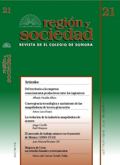 |
 |
 |
 |
 |
 |
 |
 |
 |
 |
 |
 |
Abstract
In the last years of the 19th century and in the first decade of the 20th century, northernwestern Mexico experienced a strong economic development as a result of the exploitation of its mines. Owing to this mining boom, new population centers emerged as a consequence of a migration wave attracted by job offer and a better life. The emergence of railroads facilitated undoubtedly the mobilization of these groups which moved from the center to the north of the country. These population moves are not explicable without considering the demand of manpower which was generated by the emergence of large mining companies, almost all of them foreign companies, in the States of Baja California, Sinaloa and Sonora. In this study we show that mining favored a vigorous labor market in northwestern area in the 1890-1910 period. Such process was the result of a company policy of hiring manpower. Considerable capital resources were invested and worker engagement mechanisms were created in the central and southern states. When the national manpower resource was scarce, the companies even resorted to the international market.

This work is licensed under a Creative Commons Attribution-NonCommercial 4.0 International License.
Copyright (c) 2017 Juan Manuel Romero Gil






